School's in Session
Today, I'm going to be sharing some card-by-card design stories from Strixhaven.
Blex, Vexing Pest // Search for Blex
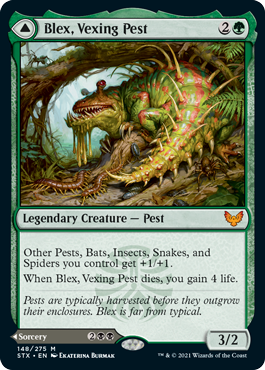
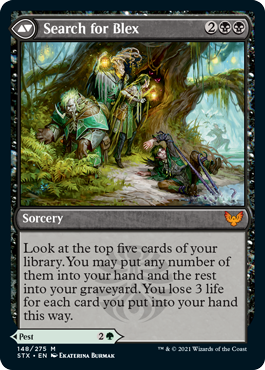
Rowan, Will, and Lukka are all MDFC planeswalkers, Rowan and Will being blue-red, and Lukka being red-white. With those in mind, we had three other slots for mythic rare MDFCs of the other three-color combinations. For each of these, the Set Design team made a legendary creature with a spell of the enemy color on the back. The order of the front and back of the planeswalker meant that the Witherbloom one was going to be a mono-green legendary creature with a mono-black spell on the backside.
The Pest creature type started out because we wanted a creature type for each school to act as that school's mascot. There wasn't a simple vanilla or French vanilla creature that worked for black-green, so we came up with a creature we called Grubs that would see print as Pests. They're 1/1 creatures that gain you 1 life when they die. Witherbloom has a "life matters" mechanical theme, and this allowed their creature token type to play into that theme.
The World Building team had a lot of fun creating the Pests, so much so that the Set Design team decided that they wanted to make a legendary Pest, and this card ended up being the perfect slot for it. Here was the team's first take on Blex:
Blex, Elusive Pest (1.0)
1GG
Legendary Creature — Pest
1/2
When CARDNAME dies, shuffle it into your library. You gain life equal to a quarter of your starting life total, rounded down. Other Pests, Insects, and Spiders you control get +X/+X, where X is CARDNAME's power.
For starters, yes Blex was called Blex from the very beginning. Blex also had the basic essence of what the final card was going to be. He was going to help other creepy-crawly creatures and gain you life when he died, although more than 1, as Blex was no ordinary Pest. You'll notice the first version only boosted Pests, Insects, and Spiders. Also, Blex started out smaller, as a 1/2, because his boosting was tied to his power.
Blex, Elusive Pest (2.0)
2G
Legendary Creature — Pest
1/2
When CARDNAME dies, shuffle it into your library. You gain 5 life.
Other Pests, Insects, and Spiders you control get +X/+X, where X is CARDNAME's power. ( // Sorcery {2BB} )
The next iteration locks down the life gain to a single number rather than a variable. I think this was because the other effect was a variable and they wanted the player to have a better sense of what the card was going to deliver. The mana cost also changed from 1GG to 2G.
Blex, Elusive Pest (3.0)
2G
Legendary Creature — Pest
1/2
When CARDNAME dies, shuffle it into your library. You gain 5 life.
Whenever CARDNAME attacks or blocks, other Pests, Insects, and Spiders you control get +X/+X until end of turn, where X is CARDNAME's power. ( // Sorcery {o2oBoB} )
The next version changes up when Blex pumps the creepy crawlies, making it combat related.
Blex, Elusive Pest (4.0)
2G
Legendary Creature — Pest
1/2
When CARDNAME dies, shuffle it into your library. You gain 5 life. Other Pests, Insects, Spiders, and Scorpions get +1/+1. ( // Sorcery {o2oBoB} )
The penultimate version simplifies the boost, making it just a static +1/+1 effect. For some reason, Scorpions get added as a creature type. I assume this meant that Scorpions were a creature type in the set for some period of time.
A few things were changed for the printed version. First, the life gain dropped from 5 to 4 and removed the shuffling in text. I assume the shuffling in text was dropped because it wasn't a play design worry that you could reanimate it and less rules text is preferred. Blex's boost added Bats and Snakes. Players have asked me why Squirrels weren't included even though there was one in the set. My best guess is they aren't animals you traditionally think of as creepy. Finally, Blex grew from a 1/2 to a 3/2.
Blex's backside Search for Blex did not change from its first version with one exception: it originally let you look at the top six cards rather than the top five.
Codie, Vociferous Codex
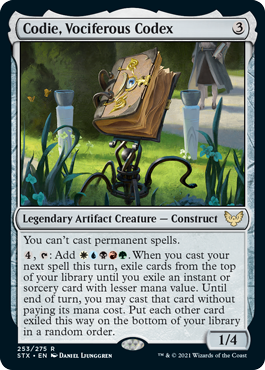
I believe Codie first came about as an idea from the Creative team during world building. If you have a magical university, why not have a super-smart animated book walking around sharing information with the students? Here's the card concept sent to the artist:
Setting: "Fencing"
Color: Legendary artifact creature
Action: We'd like you to design the legendary Codex Vocifera, a tome of mystical lore that has become self-aware. (The students have bestowed it the nickname "Codie." See p. 34 for more Codie's complete bio.) Show Codie trundling around the campus, yelling at anyone who will listen about all the spells he knows. You'll have to figure out how Codie walks and talks—maybe he sits on a small end table and the legs of the table walk him around? Maybe he has a face made of mystical symbols on the book's cover or an embossed mouth of gold foil?
Focus: The living tome "Codie"
Mood: A knowledgeable grump. "And another thing! The PROPER way to cast acid spells is with a southern orcish accent! It's like these students have never read ANY of my Chapter 94!"
Notes: No real-world words, letters, or symbols, please. Make up any runes or symbols shown.
And here's the earliest version of the card:
Codex, All-Knowing Tome
3
Artifact Creature — Construct
1/5
You can only cast instant and sorcery spells.
T: Add one mana of any color.
WUBRG, T: Look at the top 5 cards of your library. You may cast an instant and/or sorcery card from among them without paying their mana costs.
The card didn't start out as legendary. My guess is the idea might have been that the school had multiple animated books. The earliest version of the design was as a mana rock that could tap for any color, but it restricted you to only casting instants and sorceries. It then had an ability to help you get more instants and sorceries to cast.
Codie, All-Knowing Tome
3
Legendary Artifact Creature — Construct
1/4
You can only cast instant and sorcery spells.
T: Add two mana of different colors.
WUBRG, T: Reveal the top five cards of your library. Put any number of instant and/or sorcery cards from among them into your hand and the rest into your graveyard.
The next version tapped for two mana instead of one and put the instants and sorceries from the top of your deck into your hand rather than letting you cast them. My best guess behind this change was that when you spent WUBRG, you didn't often have a lot of mana left to cast the spells. Codie first became legendary in this version, getting his name, and changed from a 1/5 to a 1/4.
Codie, Vociferous Codex
3
Legendary Artifact Creature — Construct
2/2
You can't cast spells except instant and sorcery spells.
4, {oT}: Add WUBRG. When you next cast a spell this turn, reveal cards from the top of your library until you reveal an instant or sorcery card with lesser converted mana cost. You may cast that card without paying its mana cost or put it into your hand. Put all revealed cards not cast this way on the bottom of your library in a random order.
The next version was pretty close to his final version, except he was a 2/2 and his first ability talked in the positive rather than the negative. I believe his final activated ability came about because they liked the idea of the earlier version where the book cast spells rather than just drawing them for you, as it was more flavorful. It then gave you mana to allow you to cast a spell that would then "cascade" into a cheaper spell. The end result is pretty charming.
Exponential Growth
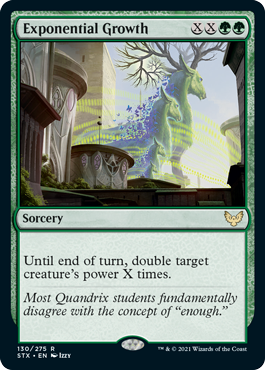
This card went through a few changes, but the name the entire time was Exponential Growth. One of the things we did early on, once we had solidified what subject each college was studying, was write names that made sense for the college and see if we could design top-down cards to match. Exponential Growth seemed like a slam dunk for the math school. Here was our first attempt:
Exponential Growth (1.0 – common)
2G
Sorcery
Double each of target creature's power and toughness until end of turn.
Version one was just a straight card that doubled power and toughness. Berserk from Alpha had been one of my favorite cards early in my Magic days, so I was excited to make something reminiscent of it. The feedback we got was "not really exponential growth." Yeah, it doubled, but only once. That led to take two:
Exponential Growth (2.0 – uncommon)
2G
Sorcery
Double each of target creature's power and toughness until end of turn.
Flashback 5G (You may cast this card from your graveyard for its flashback cost. Then exile it.)
Okay, it was the same card, but with flashback added (and moved up in rarity). As I mentioned last week, flashback had been in the set during vision design but got removed during set design. Okay, now it could double multiple times. Apparently, that still wasn't enough.
Exponential Growth (3.0 – rare)
XXG
Sorcery
Until end of turn, double target creature's power X times.
Take three added an X (actually two X's) to the mana cost so that the player could double the creature's power as many times as they had mana. To do this, we stopped doubling the creature's toughness and moved up the card's rarity again, now up to rare. The only change between version three and the printed version was the addition of an extra G in the mana cost for play design concerns.
I hope this feels like Exponential Growth.
Professor Onyx
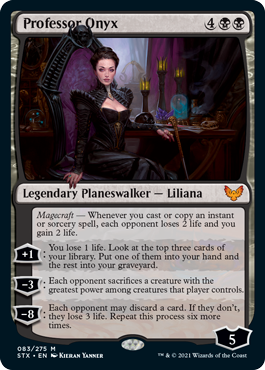
The Strixhaven file always had a spot reserved for a mono-black planeswalker, but originally this slot was tagged for Davriel. As we plotted out the larger story, however, we realized that we needed a place to check in on Liliana, who was hiding out after the events of War of the Spark, and having her be a professor just seemed like too good an opportunity to pass up. We knew from early on that she would be using a pseudonym, but her planeswalker type would be Liliana, so it was clear to everyone who she was.
Here's our first take on Professor Liliana in disguise:
Professor Elvie
3BB
Planeswalker — Liliana
Loyalty – 5
+1: Each opponent loses 2 life. You gain 2 life.
-2: You may sacrifice a creature. When you do, destroy target creature or planeswalker.
-6: Search your library for three cards and put those cards into your hand. Then shuffle your library.
The first two abilities were pretty boilerplate black abilities that Liliana had access to. The last ability, the tutor, was playing into the idea that she's a professor. I'm not sure where the name Professor Elvie came from. This ended up feeling a little boring, so we took another shot at a design for her.
Professor Black
3BB
Planeswalker — Liliana
Loyalty – 4
+1: Target opponent may discard a card. If they don't, you draw a card.
−3: You may sacrifice a creature. When you do, destroy target creature or planeswalker. You gain life equal to that permanent's converted mana cost.
−8: Search your library for three cards, put them into your hand, then shuffle your library.
We tweaked the first ability to allow a little card drawing and the second ability to help you gain some life. It was still a bit mundane. We wanted the pseudonym to tie into some essence of who Liliana was, so she became Professor Black.
Professor Onyx
4BB
Planeswalker — Liliana
Loyalty - 4
Spellcraft — Whenever you cast or copy an instant or sorcery spell, each opponent loses 2 life and you gain 2 life.
+1: You lose 2 life. Look at the top three cards of your library. Put one of them into your hand and the other into your graveyard.
−3: Each opponent sacrifices a creature with the greatest power among creatures they control.
−8: Search your library for three cards, put them into your hand, then shuffle your library.
I've mentioned in previous articles that we've been trying to make use of the set mechanics in designing our planeswalker cards, as it helps tie them to the set thematically and slows down the using up of more evergreen planeswalker design space. We ended up using magecraft (called spellcraft during design) to do a drain effect. That allowed us to then tweak the card's draw ability to make use of life as a cost and change the creature/planeswalker kill ability away from life gain. We gave up the creature sacrifice as a cost but balanced it by making the kill less directional. The ultimate stayed the same. Professor Black became Professor Onyx because Black was a little too on the nose.
The final version was pretty close to the last one. Just three changes. Liliana's starting loyalty changed from 4 to 5, her plus ability changed from 2 life to 1 life, and her ultimate completely changed. Because the first ability let Liliana search for cards, that let us make an ultimate that felt a bit more like Liliana. I believe the ability happens seven times because seven is the maximum hand size. I do enjoy the "Repeat this process six more times" template.
Quintorius, Field Historian
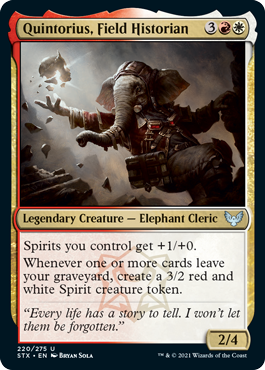
Every college got an uncommon legendary student to act as the Draft archetype build-around card. If you look through the cards, you'll see that each student has a little story that's played out over a bunch of cards in the set. Quintorius, for example, gets expelled from military school and finds his passion at Strixhaven in Lorehold studying archeology. This little elephant went through a bunch of changes in design, so I wanted to walk through them.
His slot actually didn't start as a legendary creature but as a nonlegendary enchantment, be it one that made a creature token.
Day of Remembrance
RW
Enchantment
When CARDNAME enters the battlefield, create a 1/3 red and white Spirit creature token. Nostalgia – As long as you have 5 or more cards in your graveyard, Spirits you control get +1/+0.
This is very early during vision design back when the creature token for the red-white faction was a 1/3 Spirit. (It's a 3/2 Spirit in the printed set.) One of the things we do during vision design is often labeling mechanics that show up on numerous cards, not because we believe they will necessarily be labeled in the finished product, but it makes it easier for us to see larger themes. Nostalgia was one of our attempts at helping make red-white a graveyard-based faction. I'm not sure why we chose five cards. Threshold from Odyssey block used seven, and we used eight cards in Zendikar Rising. My guess is we were trying smaller effects that we wanted to turn on earlier. Nostalgia didn't last long. It's interesting to note that Spirit pumping, which ends up on the finished card, makes its first appearance here.
Day of Remembrance (2.0)
RW
Enchantment
As long as you own 5 or more cards in your graveyard and/or in exile, Spirits you control get +1/+0.
Conjure Spirit – 1RW (If you cast this spell for 1RW, also create a 2/2 red and white Spirit creature token.)
The next version stayed an enchantment, but the creature-token generation ended up using a different mechanic that we tried, conjure. The idea behind conjure was that it was an alternative cost (as opposed to an additive cost like kicker—we've been moving toward doing more alternate costs because players don't have to do as much math) that let you play a creature token in addition to the spell. You'll notice that the Spirit token has changed from a 1/3 to a 2/2.
Day of Remembrance (3.0)
RW
Enchantment
When CARDNAME enters the battlefield, create a 3/2 red and white Spirit creature token. As long as there are three or more instant and sorcery cards in your graveyard, Spirits you control get +0/+1.
We go back to the token creation as an "enters the battlefield" effect, change the input for the Spirit pumping, and change the boost from +1/+0 to +0/+1. You'll notice the Spirit creature token changes again this time from 2/2 to 3/2. For those wanting to keep track of the timeline, this last change is the first one to happen in set design.
Day of Remembrance (4.0)
RW
Enchantment
Whenever one or more cards leave your graveyard, create a 3/2 Spirit.
The next version takes a whole new approach. We were looking for ways for red-white to care about the graveyard, and we stumbled upon an interesting one—triggering off when cards leave the graveyard. We had messed around with this trigger on a couple cards (Desecrated Tomb and Tormod, the Desecrator), and it fit nicely with red-white because both colors had the ability to exile cards from the graveyard as a cost (okay, all colors have access to it, but as subset of that, red and white could do it). Vision Design had started using this mechanic, but it didn't make its way to this slot until set design. This card now allows you to make not just one Spirit token, but many.
Primea, Student Medium
2RW
Legendary Creature – Human Cleric
2/4
Spell armor {o2} (Your opponents' spells that target this creature cost {o2} more to cast.)
Whenever one or more cards leave your graveyard, create a 3/2 Spirit.
Now the slot finally turns into a legendary creature. This first take was a medium because Lorehold, as the history college, likes to commune with spirits to hear firsthand about the past. This is the first time we see what will be called ward in the final set. R&D had been looking for a protective keyword that still allowed player interaction, and we'd been warming up to various versions of ward. We finally decided that we would keyword it, but leave it open-ended to have various costs, allowing all five colors to have access to it.
Artorius, Field Archaeomancer
3RW
Legendary Creature – Elephant Cleric
3/5
Spell armor {o2} (Your opponents' spells that target this creature cost {o2} more to cast.)
Spirits you control get +1/+1.
Whenever one or more cards leave your graveyard, create a 3/2 red and white Spirit creature token.
We finally see our elephant archeologist student for the first time, although with a different name. The one addition is that now he has a static ability that pumps Spirits. This isn't too far from his final version. The Spirit pump drops from +1/+1 to +1/+0 to allow the opponent to have answers to the Spirit army. The creature drops ward. 3/5 turns back into 2/4. And that's how we ended up with our lovable little elephant student.
Secret Rendezvous
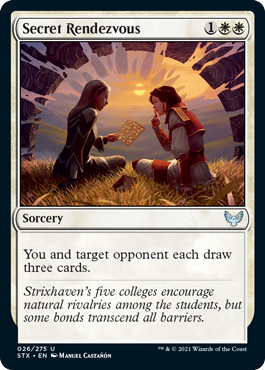
Let's talk a little bit about white card draw. White is the color that has all the answers, so to make sure it's not too efficient at answering everything, we built in two drawbacks for white. One, its removal, when inexpensive, tends to be very conditional, either in that it can be undone or that it only hits a subset of targets. Two, we made white the worst color at card draw of the five. In two-player Standard play, this worked fine for white. It could be aggressive with its creatures or it could get card advantage by doing larger defensive things like mass creature kill. The problem was this new format called Commander.
Commander changed up several fundamentals, like how much damage you must do to win and how many opponents you'll be facing. White's lack of card draw was a problem. The challenge put before the Council of Colors concerned finding some ways to give white some card drawing that fit the flavor of white and didn't cause problems in two-player play. This card is a push in the direction of one of our answers. I should stress that the white card-drawing solution is multifaceted, and I will be talking about different portions of it as they appear.
Secret Rendezvous is our first more aggressive push toward what we call "group draw." The original take on group draw was that white could draw multiple cards as long as all players drew multiple cards. Commander playtesting showed that was ineffective in solving white's draw problem, so we tweaked it. What if group draw just meant that when white drew multiple cards, some other player, but not all the players, got to draw the same number. This way, white could get cards, but it was forced to create alliances to do so.
The other nice thing about this answer is that it works very differently in multiplayer play than it does in two-player play. I'm not sure if Secret Rendezvous will see any play in two-player formats, but if it does, it's going to function in its own unique way.
What this means moving forward is that white can draw multiple cards (we're still figuring out the upper limit—this card is testing three) if you have at least one other player also drawing the same number of cards. I'm curious to see what the Commander format does with it.
That's the Bell
I hope you all enjoyed my peek behind the design of some of Strixhaven's cards. As always, I'm eager to hear your feedback on today's column, on any of the cards I talked about, or about Strixhaven: School of Mages in general. You can email me or contact me through any of my social media accounts (Twitter, Tumblr, Instagram, and TikTok).
Join me next week when I show off Strixhaven's vision design handoff document.
Until then, may you learn much from playing Strixhaven.
#823: Strixhaven Design, Part 2
#823: Strixhaven Design, Part 2
30:48
This is part two of a two-part series on the design of Strixhaven.
#824: Kaldheim with Ethan Fleischer
#824: Kaldheim with Ethan Fleischer
32:33
I sit down with Magic designer Ethan Fleischer to talk about the design of Kaldheim.
- Episode 822 Strixhaven Design, Part 1
- Episode 821 Kaladesh with Shawn Main
- Episode 820 Legendary Artifacts, Part 1

